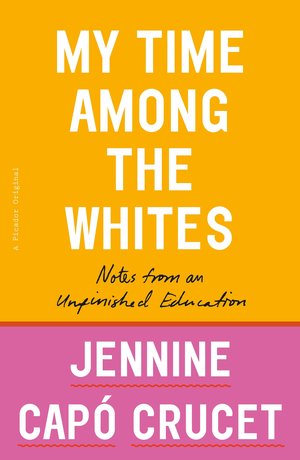Find Renee Hudson’s thoughtful and nuanced review of Jennine Capó Crucet’s My Time Among the Whites below as she explores the book’s intrinsic connection to and conversation with what the reviewer is calling the Post-Trump era of Latinx Literature. This review pairs well with Crucet’s own writing. An excerpt from her memoir can be found in the “Books” section of the September 3 issue of The Atlantic.
Courtesy of the Los Angeles Review of Books
September 3, 2019
IN THE PAST COUPLE OF YEARS, a new trend has emerged that can best be described as post-Trump Latinx literature. By “post-Trump,” I mean a nascent body of literature that critiques Trump and the ideology he represents, a counter-archive to the white supremacy that dominates the news. As Latinx authors contend with Trump’s anti-immigration rhetoric, which casts all immigrants as Mexicans and all Mexicans as criminals, this work has been a site of resistance, of hope, of sorrow.
This still-forming canon began with two interstitial entries, Javier Zamora’s Unaccompanied (2017) and Valeria Luiselli’s Tell Me How It Ends: An Essay in Forty Questions (2017), both of which straddle the shift from the Obama to the Trump administrations. While Zamora’s collection begins with the day Obama was first elected, he also includes a poem “To President-Elect” — Zamora leaves him unnamed — that marks the recent regime change. Meanwhile, Luiselli’s book, preoccupied with the 2014 refugee crisis that saw an increase in unaccompanied minors from Central America coming to the United States, ends with a coda that describes the shock of a Trump presidency and the glimmers of hope she finds in groups advocating for immigrants’ rights. José Olivarez’s Citizen Illegal, published in 2018, similarly explores this tension between terror and hope. In the most direct reference to life under Trump, “I Walk into Every Room & Yell Where The Mexicans At,” he captures the anxiety that the speaker — and Latinxs as a whole — feel among ostensibly liberal white women who we all suspect actually voted for Trump.
The post-Trump canon flourished in 2019, with the publication of Natalie Scenters-Zapico’s Lima :: Limón and Carmen Giménez Smith’s Be Recorder. Scenters-Zapico includes a poem, “Notes on My Present: A Contrapuntal,” that is split in two. The poem on the left side of the page explores the violence of empire while the poem on the right concatenates Trump’s June 16, 2015, presidential announcement — in which he calls Mexicans rapists — along with other statements he’s made about Latinxs (though he calls us “Hispanics”). Finally, Be Recorder offers an extended meditation on what it means to be “American” and challenges the United States’s arrogance in assuming exclusive use of the term.
Jennine Capó Crucet’s essay collection My Time Among the Whites (2019) is a remarkable entry within this formidable body of work. While Capó Crucet and Luiselli share an interest in the essay form, their books could not be more different. Luiselli structures Tell Me How It Ends around an intake questionnaire for immigrants. The questions detail the arduous journey Central American children take to get to the United States and the legal challenges they face while here. But Luiselli also demonstrates how the questions fail to meaningfully capture immigrants’ experiences. Capó Crucet’s book, by contrast, is an interrogation of the American Dream, of American myths, and the whiteness that undergirds it all. My Time Among the Whites is also a thoughtful exploration of what it means to be a first-generation college student, a child of immigrants, and a professor to boot. While in Tell Me How It Ends, Trump emerges at the end of the book, an addendum to what came before, in My Time Among the Whites, his presence permeates the collection. More than that, the racism and white supremacist structures that led to his rise inform Capó Crucet’s exploration of what it means to be Latinx in the time of Trump.
Like Carmen Giménez Smith’s Be Recorder, My Time Among the Whites considers how Miss America/Miss USA reflect the American Dream. For Giménez Smith, Miss America emerges as a representative of the United States. For Jennine Capó Crucet, Miss USA, the pageant organization formerly owned by Trump, is intimately tied with her birth, as her parents named her after the 1980 Miss USA runner-up, Jineane Ford. As she explains, her parents “thought that giving their American child a distinctly ethnic name came with unfair, quantifiable consequences.” Thus her naming is not just an act of assimilation, but also of passing, an intentional decision to remove ethnic barriers to their child’s success. Yet, as she heartbreakingly explains, the innovative spelling her parents chose “always flags for certain people — people looking for it — as a marker of my parents’ immigrant status, their alterations betraying the reason they went with that name in the first place.” Even as she makes the distinction between the sound of her name and its spelling, her description of her parents imagined choices gently pokes fun of them and, more importantly, of the English language, demonstrating that ultimately, she is on their side: “[W]hat is that ah sound doing in there anyway?” she writes. And really, who wouldn’t agree?
As Capó Crucet’s naming suggests, My Time Among the Whites explores the tension between immigrants’ culture and the American Dream, especially since, as the essays demonstrate so painfully, the American Dream wasn’t designed with immigrants (or people of color more generally) in mind. Growing up in Hialeah, the predominantly Cuban American city that she writes about in How to Leave Hialeah (2009), she reflects on the important role Disney World played in her life. As an adult, however, much of the magic of Disney is gone. What was once a site of pleasure becomes something more than a guilty pleasure — it becomes another site of analysis, another reinforcement of hegemonic beliefs. Describing her experience going to Disney World for her birthday, she observes, “During the days you spend in the parks, Disney will pretend you are white, American, cisgender, and straight, and everyone and everything around you will pander to and assert this understanding of the Disney fantasy.” The fantasy of Disney reveals itself to be a fantasy of whiteness, of privilege. This perhaps should not come as a surprise, but part of the magic of the Magic Kingdom is surely that one will not notice the differential treatment they receive inside and outside the park.
While such moments of analysis can take the reader out of the memoir-like moments of the book — and thus the illusion that we’re simply reading autobiographical stories — Capó Crucet’s analysis is exactly why My Time Among the Whites is vital reading for Trumpian times. As her collection demonstrates, these days the everyday aspects of growing up in the United States, of growing up American, all carry within them an overwhelming sense of foreboding. They underline our complicity, the ways we have internalized white supremacy and use it as a benchmark to measure our successes and failures.
Capó Crucet’s most extended meditation on Trump and immigration occurs in her most anxiety-producing chapter, “Going Cowboy.” There, she describes moving to Nebraska and signing up to learn how to herd cattle on a ranch. She describes how Fox News was the channel of choice in the rancher’s home, how the rancher rants “about Mexicans getting free passes into the United States.” This incident causes Capó Crucet to reflect on the rancher’s comment and point out:
[T]hat there is a Latinx group that, at the time, did benefit from that kind of special treatment. That privilege, which could be described as a free pass to citizenship, had been extended (for many years and for many complex reasons) to Cubans. Meaning, to my parents. The rancher had no idea that the manifestation of one of his greatest fears — the American-born child of these immigrants who were taking everything, everything — was sitting at his dinner table.
Here, she refers to the 1966 Cuban Adjustment Act, which allowed any Cuban who entered US waters to apply for residency after living in the United States for a year (this policy was later revised in 1995 to only apply to dry land, thus the name “wet foot, dry foot”). In making this oblique reference, Capó Crucet emphasizes the asymmetrical privileges afforded to some immigrants over others, particularly from Latin America. Reading her words, “the American-born child of these immigrants who were taking everything, everything,” I couldn’t help but think about the cruel joke that makes her the manifestation of nativist fears: an associate professor, a successful writer, a person committed to her community. But of course, this is the actual fear — that immigrants and their children will be more successful than their white peers, demonstrating that having all the privileges and advantages in life does not make one successful. The fear is of excellence, not crime.
In moments like this, Capó Crucet’s clear-eyed examination of whiteness demonstrates that Trump isn’t what ails us; he’s the symptom, not the disease. This becomes particularly clear in her deft analysis of Latinxs’ conflicted relationship with whiteness — a relationship that demonstrates our complicity in the systems that oppress us. In Latin America and among Latinxs, lighter skin is still valued over darker skin, an idea expressed by the term “mejorar la raza” or “improve the race,” which generally refers to marrying someone with lighter skin to further whiten the subsequent children and thus, future generations. In My Time Among the Whites, Capó Crucet explores what it means to “a kind of white” as well as “to realize that I was not white.” In her telling, her whiteness reveals itself in moments of privilege: when she doesn’t consider demographic information in making a decision, when she doesn’t immediately realize that an all-white space may not be a safe one.
The moments when the differences between Cuban American whiteness and white American whiteness come up span a range of experiences, from having to explain why she won’t get a sunburn on her ears to learning that dancing is a dead giveaway for her Latinx roots. Yet, even as she discusses the elision between the American Dream and whiteness — through her name, through Disney World, through light skin — Capó Crucet carefully points out that Cuban American whiteness is an illusion of whiteness, at least in this America. Of the 2016 election, she remarks, of her parents and their generation,
They didn’t realize that not voting — the ultimate gesture of complacency — was a privilege they didn’t actually have: It only felt that way because they lived in Miami, a place where it was easy to think, if you were Cuban, that you were white and therefore not part of the immigrant groups Trump was making a campaign out of promising to deport.
As she notes above and as all Latinxs know: When Trump and other white supremacists name a specific Latinx group, they really mean all of us. It doesn’t matter if the group is Mexican or Guatemalan, citizen or non-citizen, criminal or non-criminal — when Trump refers to any of us, he refers to all of us.
In My Time Among the Whites, and in what I’m calling post-Trump Latinx literature, the 2016 election emerges as a flashpoint that highlights, on the one hand, the specific complicity between Latinxs and white supremacy, and, on the other hand, how Latinx authors are building a resistance canon. According to The New York Times, 29 percent of Latinxs voted for Trump. While that might not seem like much, especially considering that 27 percent of Latinxs voted for Mitt Romney in 2012, it is surprising because Trump built his platform on explicitly anti-Latinx policies. As Capó Crucet points out, many Latinxs didn’t vote at all; as I can attest, some of us have family members who did vote, but voted for Trump. Within these complex dynamics, My Time Among the Whites emerges as a salve. It incisively traces the ideologies that led to Trump, such as the American Dream, and indicts our adherence to these ideologies, many of which are deeply internalized. None of us are blameless, but when Capó Crucet writes, of predominantly white campuses, “[t]his place never imagined you here, and your exclusion was a fundamental premise in its initial design,” she’s also writing about the United States writ large. We may always be among the whites, but as post-Trump Latinx literature demonstrates, we can resist a world that privileges whiteness. And we must use the time while we still have it.




